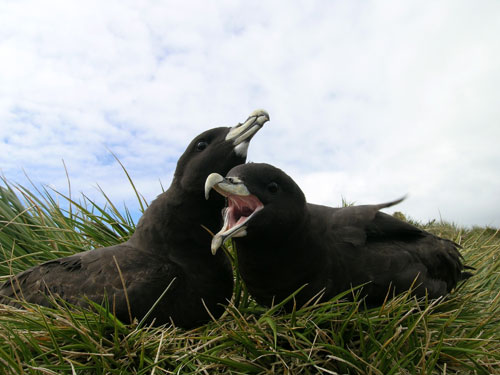Juan Pablo Seco Pon (Departamento de Biología, Facultad de Ciencias Exactas y Naturales, Universidad Nacional de Mar del Plata, Argentina and ACAP South American News Correspondent) and colleagues have looked at trace metal levels in White-chinned Petrel Procellaria aequinoctialis feathers from off Argentina, publishing their findings in the first issue of a new open-access journal Environment and Pollution.
The paper's abstract follows
"Cd, Cr, Cu, Fe, Ni, Pb, and Zn were measured in feathers from male and female White-chinned petrels Procellaria aequinoctialis accidentally killed in longliners off Argentina in 2005. Cd, Pb, and Ni concentrations in adult feathers were below detection limits regardless of the birds' sex. Metal concentrations did not vary with sex for Cu, Fe and Zn in feathers of adult birds despite significant differences in body size between males and females. The Cu and Fe concentrations differed significantly between the type of feather within individual birds. The mean concentrations of metals determined here were within the range of concentrations reported in feather tissues of other related Procellariiformes species from different biogeographic areas. However, the concentrations of Cr were similar to those reported for other petrels from polluted areas of the North Pacific. Thus, it appears likely that levels of pollution in Patagonia may not be as negligible as previously thought for some trace metals."

White-chinned Petrels. Photograph by Ben Phalan
Click here to read about an earlier paper by the same authors on trace metal levels in Black-browed Albatrosses Thalassarche melanophris form the south-west Atlantic.
References:
Seco Pon, J.P., Beltrame, O., Marcovecchio, J., Favero, M. & Gandini, P. 2011. Trace metals (Cd, Cr, Cu, Fe, Ni, Pb, and Zn) in feathers of Black-browed Albatross Thalassarche melanophrys attending the Patagonian Shelf. Marine Environmental Research 72: 40-45.
Seco Pon, J.P, Beltrame, O., Marcovecchio, J., Favero, M. & Gandini, P. 2012. Assessment of trace metal concentrations in feathers of White-chinned Petrels, Procellaria aequinoctialis, from the Patagonian Shelf. Environment and Pollution 1: 29-37.
With thanks to Juan Pablo Seco Pon, ACAP South American News Correspondent, for the alert.
John Cooper, ACAP Information Officer, 16 January 2012

 English
English  Français
Français  Español
Español